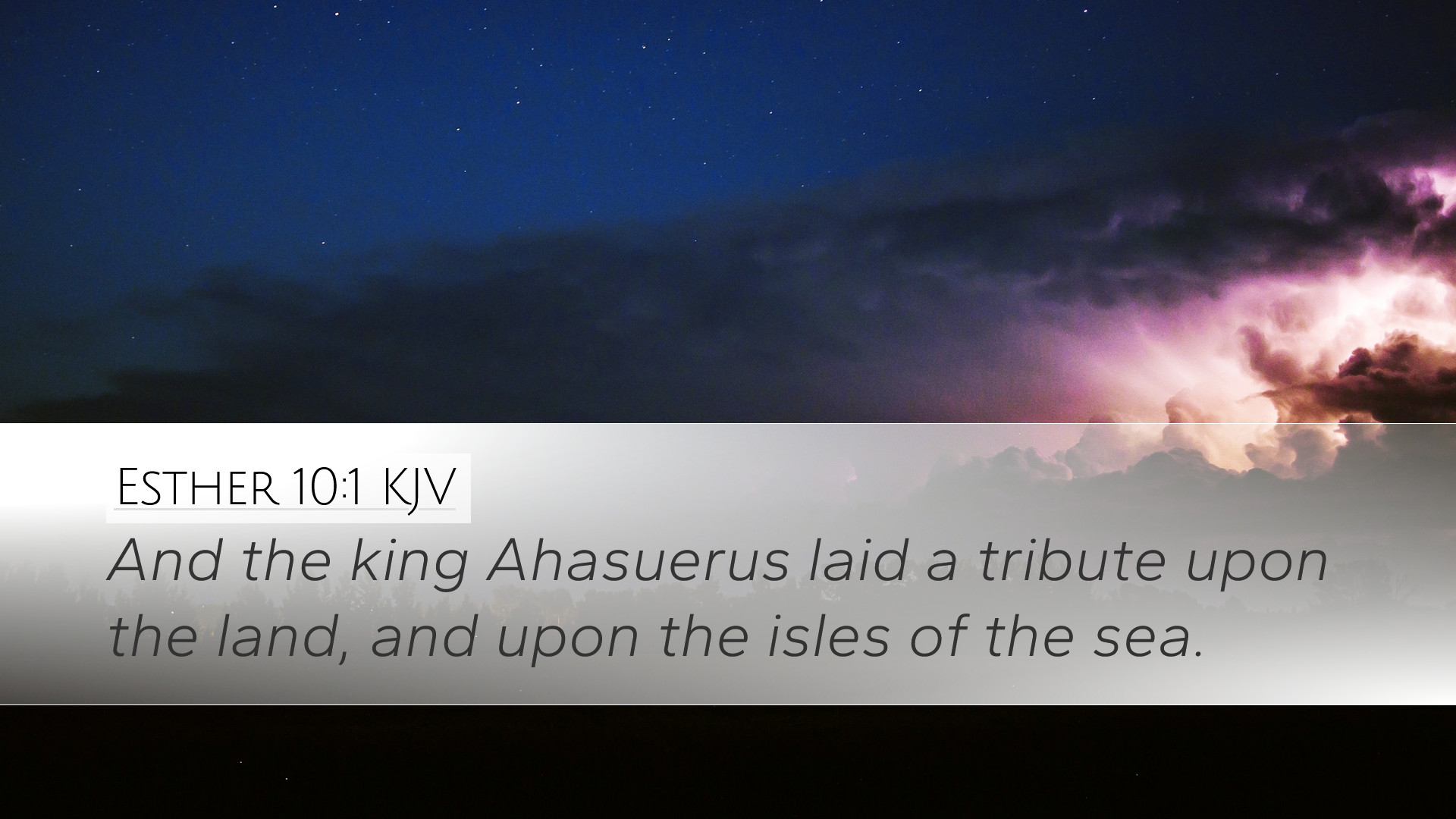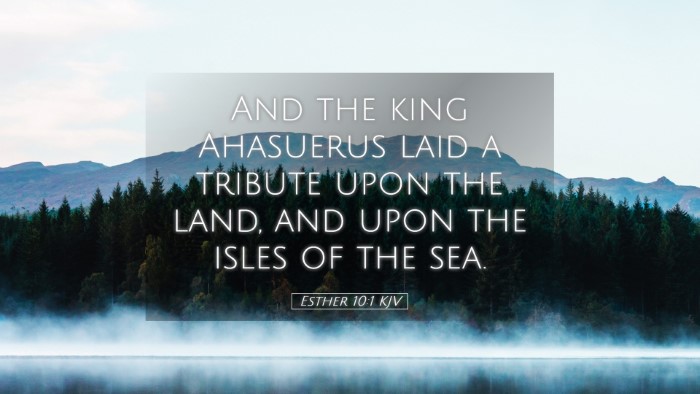Old Testament
Genesis Exodus Leviticus Numbers Deuteronomy Joshua Judges Ruth 1 Samuel 2 Samuel 1 Kings 2 Kings 1 Chronicles 2 Chronicles Ezra Nehemiah Esther Job Psalms Proverbs Ecclesiastes Song of Solomon Isaiah Jeremiah Lamentations Ezekiel Daniel Hosea Joel Amos Obadiah Jonah Micah Nahum Habakkuk Zephaniah Haggai Zechariah MalachiEsther 10:1
Esther 10:1 KJV
And the king Ahasuerus laid a tribute upon the land, and upon the isles of the sea.
Esther 10:1 Bible Commentary
Commentary on Esther 10:1
Esther 10:1 states, "And the king Ahasuerus laid a tribute upon the land, and upon the isles of the sea." This short yet significant verse provides insights into the governance of King Ahasuerus and serves as a hinge for the events recounted in the Book of Esther. The following commentary incorporates insights from notable public domain commentators including Matthew Henry, Albert Barnes, and Adam Clarke.
Contextual Overview
Leading up to this verse, the Book of Esther has narrated the remarkable deliverance of the Jewish people from the plot of Haman. The events surrounding Esther's rise to queen and the subsequent decree for the Jews' extermination are vital points preceding this final chapter. It is evident that the providential hand of God operated magnificently, turning a decree of destruction into a narrative of preservation and celebration.
Verse Analysis
King Ahasuerus’ Authority
Matthew Henry points out that Ahasuerus, recognized as a monarch with vast dominion, imposed a tribute. This act reveals not only his authority but also the administrative tasks expected of him as a ruler. Paul asserts in Romans 13:1 that every soul is subject to higher powers, and here, we see the practical application of such governance. A tribute signifies that the kingdom was under his control and subjected to his fiscal policies.
The Tribute Imposed
Albert Barnes emphasizes the 'tribute' as a form of taxation that was imposed upon the people. This tribute had broader implications that reflect on societal hierarchies and economic structures of the time. The tributes acted both as a source of revenue for the kingdom and a means to assert the king’s authority over his subjects. Further, Barnes suggests that this taxation, even as it funded royal endeavors, also served as a unifying mechanism for the diverse lands under Ahasuerus’ rule.
Geopolitical Implications
Adam Clarke addresses the geographical elements of the verse—particularly the mention of "the isles of the sea." Clarke notes that this indicates Ahasuerus’ influence extended across maritime territories. It reflects the reach of the Persian Empire and demonstrates that tribute was not confined to the mainland but included distant lands, symbolizing the vastness of Persian power.
Theological Reflections
Divine Providence
This verse is significant in highlighting the overarching theme of God’s providence throughout the narrative of Esther. As Henry indicates, the imposition of the tribute comes after a series of miraculous events that led to the Jews' deliverance. The tribute essentially becomes part of the structural order that God established for the safety and sustenance of His people. It illustrates how God’s plans are often carried out through the structures of human authority, reflecting Romans 8:28 where all things work together for good.
Lessons on Leadership
The verse stands as a reminder to modern leaders and authorities about the burden and responsibility that comes with governance. Albert Barnes reflects that true leadership requires effective management of resources and fair treatment of the populace. Leaders today can learn from Ahasuerus that wise stewardship of authority can influence the well-being of communities and contribute positively to societal order.
The Nature of Tribute and its Spiritual Meaning
The concept of tribute also carries a deeper spiritual significance. Just as Ahasuerus demanded tribute from his subjects, believers are reminded of their call to give tribute to God—through worship, service, and obedience. Clarke notes that this dedication is not merely about financial giving, but encompasses honoring God in all aspects of life.
Conclusion
In summary, Esther 10:1 serves as a conclusion to the narrative of Esther, reinforcing themes of authority, providential care, and the implications of governance. It encapsulates the triumph of the Jewish people and the establishment of a new order under Ahasuerus—a tribute to the enduring narrative of faith and deliverance. Understanding the full context of this verse invites pastors, students, theologians, and Bible scholars to reflect on the complex interplay of divine providence and human authority.
Key Themes for Further Study
- God’s providence in historical narratives
- Authority and responsibility in leadership
- The socioeconomic structures of ancient Empires
- Spiritual tributes in the life of a believer


